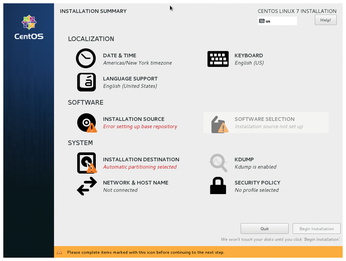Bringing Up Clouds
First as a buzzword and then as a commodity, the cloud lives the typical life of an IT industry phenomenon. This means that running something (but usually Linux) in a cloud is a thing you now do more often than not. From a user perspective, it's simple: You click a button on the cloud provider's dashboard and get your virtual machine (VM) running within a minute.
This is drastically different from what you do on your desktop. Here, you insert the DVD or plug in a USB pen drive and spawn the installer. Be it an old-school, text-based or a slick GUI installer, it typically asks you some questions (Figure 1). Which locale do you want to use? What's your computer's hostname? What's your time zone? How do you want your user account named? Which password do you want to use? You may not even notice these questions, because installation takes a quarter of an hour or more, and you spend most of this time sipping coffee or chatting with friends. Yet these questions are essential for the system's operation. Without a password, you won't be able to log in. Or, even worse, everyone will be able to.
[...]
Buy this article as PDF
(incl. VAT)
Buy Linux Magazine
Subscribe to our Linux Newsletters
Find Linux and Open Source Jobs
Subscribe to our ADMIN Newsletters
Support Our Work
Linux Magazine content is made possible with support from readers like you. Please consider contributing when you’ve found an article to be beneficial.

News
-
Parrot OS Switches to KDE Plasma Desktop
Yet another distro is making the move to the KDE Plasma desktop.
-
TUXEDO Announces Gemini 17
TUXEDO Computers has released the fourth generation of its Gemini laptop with plenty of updates.
-
Two New Distros Adopt Enlightenment
MX Moksha and AV Linux 25 join ranks with Bodhi Linux and embrace the Enlightenment desktop.
-
Solus Linux 4.8 Removes Python 2
Solus Linux 4.8 has been released with the latest Linux kernel, updated desktops, and a key removal.
-
Zorin OS 18 Hits over a Million Downloads
If you doubt Linux isn't gaining popularity, you only have to look at Zorin OS's download numbers.
-
TUXEDO Computers Scraps Snapdragon X1E-Based Laptop
Due to issues with a Snapdragon CPU, TUXEDO Computers has cancelled its plans to release a laptop based on this elite hardware.
-
Debian Unleashes Debian Libre Live
Debian Libre Live keeps your machine free of proprietary software.
-
Valve Announces Pending Release of Steam Machine
Shout it to the heavens: Steam Machine, powered by Linux, is set to arrive in 2026.
-
Happy Birthday, ADMIN Magazine!
ADMIN is celebrating its 15th anniversary with issue #90.
-
Another Linux Malware Discovered
Russian hackers use Hyper-V to hide malware within Linux virtual machines.


